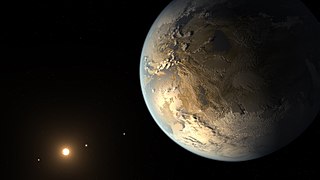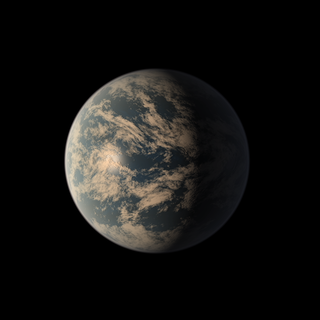Related Research Articles

An exoplanet or extrasolar planet is a planet outside the Solar System. The first possible evidence of an exoplanet was noted in 1917, but was not recognized as such. The first confirmation of detection occurred in 1992. A different planet, originally detected in 1988, was confirmed in 2003. As of 1 January 2022, there are 4,905 confirmed exoplanets in 3,629 planetary systems, with 808 systems having more than one planet.

A terrestrial planet, telluric planet, or rocky planet, is a planet that is composed primarily of silicate rocks or metals. Within the Solar System, the terrestrial planets accepted by the IAU are the inner planets closest to the Sun, i.e. Mercury, Venus, Earth, and Mars. Among astronomers who use the geophysical definition of a planet, two or three planetary-mass satellites – Earth's Moon, Io, and sometimes Europa – may also be considered terrestrial planets; and so may be the rocky protoplanet-asteroids Pallas and Vesta. The terms "terrestrial planet" and "telluric planet" are derived from Latin words for Earth, as these planets are, in terms of structure, Earth-like.

55 Cancri e is an exoplanet in the orbit of its Sun-like host star 55 Cancri A. The mass of the exoplanet is about 8.63 Earth masses and its diameter is about twice that of the Earth, thus classifying it as the first super-Earth discovered around a main sequence star, predating Gliese 876 d by a year. It takes less than 18 hours to complete an orbit and is the innermost-known planet in its planetary system. 55 Cancri e was discovered on 30 August 2004. However, until the 2010 observations and recalculations, this planet had been thought to take about 2.8 days to orbit the star. In October 2012, it was announced that 55 Cancri e could be a carbon planet.

This is a list of exoplanets. As of 1 January 2022, there are 4,905 confirmed exoplanets in 3,629 planetary systems, with 808 systems having more than one planet. Most of these were discovered by the Kepler space telescope. There are an additional 2,366 potential exoplanets from Kepler's first mission yet to be confirmed, as well as 889 from its "Second Light" mission and 1,385 from the Transiting Exoplanet Survey Satellite (TESS) mission.

A super-Earth is an extrasolar planet with a mass higher than Earth's, but substantially below those of the Solar System's ice giants, Uranus and Neptune, which are 14.5 and 17 times Earth's, respectively. The term "super-Earth" refers only to the mass of the planet, and so does not imply anything about the surface conditions or habitability. The alternative term "gas dwarfs" may be more accurate for those at the higher end of the mass scale, although "mini-Neptunes" is a more common term.

An exoplanet is a planet located outside the Solar System. The first evidence of an exoplanet was noted as early as 1917, but was not recognized as such until 2016; no planet discovery has yet come from that evidence. What turned out to be the first detection of an exoplanet was published among a list of possible candidates in 1988, though not confirmed until 2003. The first confirmed detection came in 1992, with the discovery of terrestrial-mass planets orbiting the pulsar PSR B1257+12. The first confirmation of an exoplanet orbiting a main-sequence star was made in 1995, when a giant planet was found in a four-day orbit around the nearby star 51 Pegasi. Some exoplanets have been imaged directly by telescopes, but the vast majority have been detected through indirect methods, such as the transit method and the radial-velocity method. As of 1 January 2022, there are 4,905 confirmed exoplanets in 3,629 planetary systems, with 808 systems having more than one planet. This is a list of the most notable discoveries.

HIP 11915 b is an exoplanet orbiting the solar twin star HIP 11915 about 190 light-years (57 parsecs, or nearly 1.798×1015 km) from Earth in the constellation Cetus. It is notable as the first exoplanet to be discovered with an orbit and mass similar to that of Jupiter (essentially, a "Jupiter analog"), suggesting that its system may be similar to that of the Solar System. It orbits its star at a distance of approximately 4.8 AU. The exoplanet was found by using the radial velocity method, where periodic Doppler shifts of spectral lines of the host star suggest an orbiting object.

Kepler-452 is a G-type main-sequence star located about 1,800 light-years away from Earth in the Cygnus constellation. Although similar in temperature to the Sun, it is 20% brighter, 3.7% more massive and 11% larger. Alongside this, the star is approximately six billion years old and possesses a high metallicity. Thus, Kepler-452 can be considered a solar twin, although it could be considered a solar analog due to its age.

TRAPPIST-1d, also designated as 2MASS J23062928-0502285 d, is a small exoplanet (about 30% the mass of the earth), which orbits on the inner edge of the habitable zone of the ultracool dwarf star TRAPPIST-1 approximately 40 light-years (12.1 parsecs, or nearly 3.7336×1014 km) away from Earth in the constellation of Aquarius. The exoplanet was found by using the transit method, in which the dimming effect that a planet causes as it crosses in front of its star is measured. The first signs of the planet were announced in 2016, but it wasn't until the following years that more information concerning the probable nature of the planet was obtained. TRAPPIST-1d is the least massive planet of the system and is likely to have a compact hydrogen-poor atmosphere similar to Venus, Earth, or Mars. It receives just 4.3% more sunlight than Earth, placing it on the inner edge of the habitable zone. It has about <5% of its mass as a volatile layer, which could consist of atmosphere, oceans, and/or ice layers. Recent studies by the University of Washington have concluded that TRAPPIST-1d might be a Venus-like exoplanet with an uninhabitable atmosphere. The planet is an eyeball planet candidate.

TRAPPIST-1e, also designated as 2MASS J23062928-0502285 e, is a solid, close-to-Earth-sized exoplanet orbiting within the habitable zone around the ultracool dwarf star TRAPPIST-1 approximately 40 light-years away from Earth in the constellation of Aquarius. Astronomers found the exoplanet by using the transit method, in which the dimming effect that a planet causes as it crosses in front of its star is measured.
K2-138b is a potentially rocky Super-Earth exoplanet orbiting every 2 days around a K1V star. The planet, along with the four others in the system, was found by citizen scientists of the Exoplanet Explorers project on Zooniverse. It was the final planet found in the system and was officially announced on January 8, 2018.

HD 89345 b is a Neptune-like exoplanet that orbits a G-type star. It is also called K2-234b. Its mass is 35.7 Earths, it takes 11.8 days to complete one orbit of its star, and is 0.105 AU from its star. It was discovered by 43 astrophysicists, one which is V. Van Eylen, and is announced in 2018.

HD 21749 is an orange main-sequence star about 0.68 the mass of the Sun in the constellation Reticulum, located about 53 ly (16 pc) from Earth. On 7 January 2019, it was announced that the star has two exoplanets: a possibly rocky, hot sub-Neptune-sized exoplanet, named HD 21749b; and, a sub-Earth exoplanet, tentatively named HD 21749c. These exoplanets were discovered by the Transiting Exoplanet Survey Satellite (TESS).

HIP 65426 b is a super Jupiter exoplanet orbiting the star HIP 65426. It was discovered on 6 July 2017 by the SPHERE consortium using the Spectro-Polarimetric High-Contrast Exoplanet Research (SPHERE) instrument belonging to the European Southern Observatory (ESO). It is 385 light-years from Earth. It is the first planet discovered by ESO's SPHERE instrument.

Kepler-1649c is an Earth-sized exoplanet, likely rocky, orbiting within the habitable zone of the red dwarf star Kepler-1649, the outermost planet of the planetary system discovered by Kepler’s space telescope. It is located about 301 light-years (92 pc) away from Earth, in the constellation of Cygnus.
L 98-59 is a bright M dwarf star, located in the constellation of Volans, at a distance of 10.623 ± 0.003 parsecs, or 34.648 ± 0.01 light-years, as measured by Gaia.
References
- ↑ "Exoplanet-catalog". Exoplanet Exploration: Planets Beyond our Solar System. Retrieved 2021-03-23.
- ↑ "The Extrasolar Planet Encyclopaedia — G 9-40 b". exoplanet.eu. Retrieved 28 March 2021.